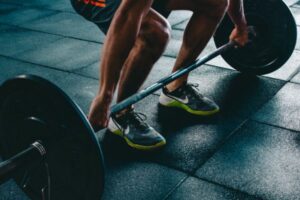
the Differences Between Core & Abdominal Training
Core and Abdominal Training
Core training and abdominal training are two common fitness trends these days. However, core training and abdominal training are easy to confuse or mix up due to the similar focus they have. “Flat abs” is a common goal for most exercisers, which drives people to spend a lot of their training time on abdominal exercises in the hopes of reaping significant performance benefits. In fact, there is a clear distinction between core and abdominal training in terms of objectives, anatomy, and functional considerations. The core is the connecting link between the upper and lower extremities in the human body, considered the beginning of body movement. In the human body, the center of gravity is concentrated in the trunk through the pelvis and lower back. This is the core of the human balance system. Therefore, the core has a significant effect on the movement of the body.
Anatomy and Function of the Core and Abdominal Muscles
The ‘core’ refers to the muscle groups stabilizing or moving the trunk. The diaphragm, pelvic floor, transverse abdominis, and internal oblique are primarily expiratory muscles, resisting forces causing lung collapse and compressing the abdominal contents to increase intra-abdominal pressure. The rectus abdominis, which are most emphasized during traditional abdominal training, collectively flex the trunk or can act independently to rotate the lumbar spine while the rectus sheaths. The external obliques and rectus abdominis are primarily trunk flexors, pulling down on the lower sternum and rib cage. The external obliques are the largest of the oblique muscles and help the back muscles in rotating the trunk and maintaining correct posture. Their main function is to act as a core stabilizer and to maintain the spine’s structural integrity.(1)
The transverse abdominis is transversely oriented and is deep within the abdominal wall. It works in concert with the multifidus. It helps to co-contract to stabilize the core. The corset muscles help to support the lumbar spine. The transversus abdominis is the deepest muscle in the abdominal wall and is one of the muscles that is activated during injection. It is also the muscle that provides the most attachment sites for covering the lumbar spinal extensor muscles such as the multifidus. Ab training is rarely designed to specifically target this muscle, but a strong corset will aid in everyday lifting tasks and better posture. The internal obliques are positioned above the transversus abdominis and help support internal organs while maintaining good posture. Their sling-type action with the pelvis and transversus abdominis helps prevent lordosis. The lumbodorsal fascia and muscles provide stabilization while lifting and work in direct relation with the corset and TVA. Each of these muscles plays some role in stabilization and strength related to the spine. Avoid classifying your program as strictly “core” training or “abdominal training” without a better understanding of the specific anatomy portrayed.(2)
Discerning the anatomical background for that region will give insight to target the results of training. When we understand the function of the few muscles considered in ab training, the approach to the various exercises and training protocols becomes more sophisticated and well-rounded. However, unless an individual has an understanding of the primary functioning of the considered muscles, the result may end up being too much weight used and an overemphasis on sagittal plane trunk flexion exercises, which do not really target the entire core. The main function of the muscles that are considered in ab training is to produce concentric and eccentric movement actions, ranging from mild movements like when sitting down to heavy lifting movements. The primary function, given the insertion and origin of each respective muscle in the abdominals, is to flex and extend posteriorly, rotationally, and laterally flex the trunk and cervical spine. These primary movements can bear muscle trends that trigger loading and therefore can be developed and strengthened in the superficial fibers of these muscles. Consideration should also be taken in regard to fiber types that have atrophied due to lack of exercise and should be catered for in order to correct musculoskeletal imbalance. Training these functions should therefore bring about an increase in athleticism and carryover to activities of daily living and correct exercising techniques.(3)
Key Differences in Training Techniques and Exercises
The approach that a person takes with his or her training strategy makes a world of difference in the overall results seen in that individual. This is seen when comparing the techniques used in core training and abdominal training regimens, as these two are drastically different from one another. Of primary concern when engaging in a core training routine is the baby step method of simplification. Fundamentally, this means that the ideal path here is an emphasis on stabilization exercises that have very human functionality. Oftentimes, this type of method will entail the use of either tape, proprioception exercises, or a combination of both. Exercises in core training cover a broad range that could include planks or other stabilization exercises such as shoulder touches or other stability ball workouts. Other familiar implements include the use of medicine balls and weight training.(4)
For a very specific example, a good core workout would typically incorporate a number of exercises involving the body in a kneeling position and actual visualization. When we guide our discussion into the realm of abdominal training, we have to assume a much less functional posture. These exercises are more narrow in their focus, centering on muscle hypertrophy when the abdominal exercises get into the prime section of their action. This is in stark contrast to the philosophy about always attempting to involve as much of the human body as possible during a movement. The traditional lineup of sit-ups and crunches will fit the bill here, as it attempts to carve out moderate to greater degrees of strength and resistance. That said, if we really want to aim to cover all of our bases, it is important to include stomach/core work that focuses on motor insufficiency, stress testing, balance, reactive actions, and general stability. Each component presented traces back in some capacity to core. This guiding reasoning is what underlies efforts to mesh core stabilization skills, abdominal training movement patterns, and core flexibility into a total program that operates in the realm of general fitness and injury prevention. With that in mind, direct spine loading considerations identified include: the goal of the individual structure of a training routine; strength conditioning with a focus on flexibility.(5)
Benefits of Incorporating Both Core and Abdominal Training
While the nuances of core training and abdominal training lend to distinct and unique goals, the general training design has a lot of synergies. As in all components of a well-rounded program, it is beneficial to have variety and dynamic range in the movements and exercises day-to-day. Therefore, it makes sense to incorporate both core training and abdominal training into a fitness routine with an appropriate balance for the individual and the routine. Both training types share the overarching benefit of preventing injury, which results in improved athletic ability. Ultimately, the muscles of the abdomen help strengthen and define, while the muscles of the core offer athletic endurance and strength, increased stability and balance, and more efficient and powerful movement patterns. By incorporating both styles of training, we can even out physical symmetry and improve bodily composition.
Both core and abdominal training are effective methods for combating weaknesses in the body. While the muscles in the abdomen region help prevent the spine from curving, good core training can improve straight-line posture. In turn, this assists in freeing the diaphragm, improving respiration and lung capacity, as well as eliminating physical restrictions so that the muscles within the body can work more effectively. The principal purpose, effects, and principles behind core training are very different from those of abdominal training. This is why a training program should include elements of both. A balanced core expression can be achieved not only through engaging the muscles in the abdomen but also by training the inner unit. Depending on the main benefits and end goal of a routine, certain individuals might favor core training over abdominal training – and vice versa. Still, a properly balanced regimen will incorporate some form of both.
Recommendations for Optimal Fitness
The primary difference between core training and abdominal training is not one of semantics or of precious theories, but of function. It is from this functional definition that programs for each can be developed; core training prepares the muscles for dynamic, full-body functional movement, and abdominal training allows for hypertrophy, endurance, and often, timed endurance.
For a safe, effective, and integrated wellness and/or fitness program, address local motion first, either within the program itself or as active recovery between more integrated exercises. Recognize that the “powerhouse” requires strength, flexibility, and coordination if it is to generate power safely. Throughout the training, encourage consistent and increasing awareness of alignment, especially nodal alignment, and work in the alignment of the body. Core and abdominal training can no longer be approached with a separatist mentality if we are to fulfill our public health mission of helping individuals achieve fitness and wellness.
The advice is to both understand and apply the techniques for core and abdominal training as part of a comprehensive approach to fitness and health. Start by assessing the abdominals and back for baseline strength, flexibility, and endurance. Recognize that abdominal endurance might take some time to develop and explain to clients that pelvic and spine position should be the strongest concerns. Guidelines for healthy adults recommend a minimum of one set of 8 to 12 repetitions of a resistance weight to challenge each group of muscles, with resistance that is to be lifted between 8-12 times to fatigue the muscles. For people who are already fit, several sets of 12-20 reps will challenge their abdominal and back muscles, which should then be trained three times per week.
Work the six muscles around the sit-up and knee bend together for an improved outcome. A sample training program to address the core-four is one of several featured. In each case, strive for aligned motion without compensation. Build in regular reassessments and seven-day progressions. Dynamic movement against gravity is best for an overall, more functional workout that is part of a top-to-bottom workout program.


